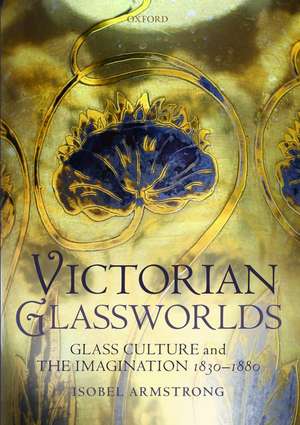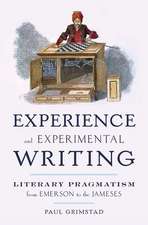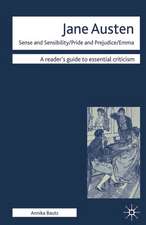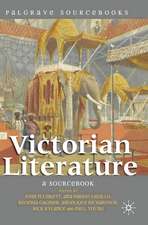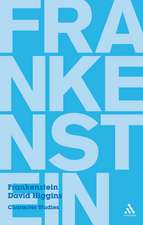Victorian Glassworlds: Glass Culture and the Imagination 1830-1880
Autor Isobel Armstrongen Limba Engleză Hardback – 23 apr 2008
Preț: 509.29 lei
Preț vechi: 612.10 lei
-17% Nou
Puncte Express: 764
Preț estimativ în valută:
97.45€ • 101.75$ • 80.65£
97.45€ • 101.75$ • 80.65£
Carte tipărită la comandă
Livrare economică 24-31 martie
Preluare comenzi: 021 569.72.76
Specificații
ISBN-13: 9780199205202
ISBN-10: 0199205205
Pagini: 472
Ilustrații: 125 black-and-white illustrations
Dimensiuni: 180 x 255 x 30 mm
Greutate: 1.09 kg
Editura: OUP OXFORD
Colecția OUP Oxford
Locul publicării:Oxford, United Kingdom
ISBN-10: 0199205205
Pagini: 472
Ilustrații: 125 black-and-white illustrations
Dimensiuni: 180 x 255 x 30 mm
Greutate: 1.09 kg
Editura: OUP OXFORD
Colecția OUP Oxford
Locul publicării:Oxford, United Kingdom
Recenzii
Intellectually, theoretically, and methodologically, Victorian Glassworlds is a remarkable study to which scholars working in the field of Victorian studies will return again and again.
Armstrong's book is a jewel among academic publications... It is a multifaceted book, the complexity of which - both theoretical and rhetorical - is impressive.
a challenging, major work
Richly researched... A book of great originality and even greater ambition.... in chapter after chapter, Armstrong succeeds in bringing both wide-angle and close-up views of the nineteenth century into fresh focus... a major work
Sumptous production quality and copious illustrations... This challenging book is worth the effort for the new window it opens on the crucially important Victorian period.
Like the world of glass it describes, this is a book of gleaming virtuosity. We quickly enter a vision of Victorian England that is dazzlingly new - a glass democracy of crystal boulevards and aerial spaces. Light comes flashing to us from every direction, even as the image of human labour and breath remains steadily in view.
a brilliant and challenging exploration... remarkable
this marvellous book tells the story of the creation, in the nineteenth century, of whole worlds of glass, with languages and cultures to go with each of them. There is news on every page, and lovingly evoked detail in profusion, but there is also deeply reflective thought and theory. Anyone else might have got lost among these treasures, but Isobel Armstrong always knows just where she is, even when, especially when, she manages to be in so many places at once. Her learning is prodigious but so is her unfailing and enticing clarity.
the book embodies its subject matter by casting prismatic rays of thought in a myriad of unexpected directions
a thoughtful, painstaking and impressively scholarly book which covers an enormous amount of ground in some detail. It will be invaluable resource for serious students of Victorian society, arts and culture
a rich, vituoso concoction of literary and historical sources ... It is full of clever and challenging ideas about a material that, since the Victorian period, has become an essential component of modern life.
Armstrong's book is a jewel among academic publications... It is a multifaceted book, the complexity of which - both theoretical and rhetorical - is impressive.
a challenging, major work
Richly researched... A book of great originality and even greater ambition.... in chapter after chapter, Armstrong succeeds in bringing both wide-angle and close-up views of the nineteenth century into fresh focus... a major work
Sumptous production quality and copious illustrations... This challenging book is worth the effort for the new window it opens on the crucially important Victorian period.
Like the world of glass it describes, this is a book of gleaming virtuosity. We quickly enter a vision of Victorian England that is dazzlingly new - a glass democracy of crystal boulevards and aerial spaces. Light comes flashing to us from every direction, even as the image of human labour and breath remains steadily in view.
a brilliant and challenging exploration... remarkable
this marvellous book tells the story of the creation, in the nineteenth century, of whole worlds of glass, with languages and cultures to go with each of them. There is news on every page, and lovingly evoked detail in profusion, but there is also deeply reflective thought and theory. Anyone else might have got lost among these treasures, but Isobel Armstrong always knows just where she is, even when, especially when, she manages to be in so many places at once. Her learning is prodigious but so is her unfailing and enticing clarity.
the book embodies its subject matter by casting prismatic rays of thought in a myriad of unexpected directions
a thoughtful, painstaking and impressively scholarly book which covers an enormous amount of ground in some detail. It will be invaluable resource for serious students of Victorian society, arts and culture
a rich, vituoso concoction of literary and historical sources ... It is full of clever and challenging ideas about a material that, since the Victorian period, has become an essential component of modern life.
